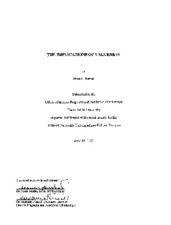The implications of vagueness
| dc.creator | Rester, Jesse L | |
| dc.date.accessioned | 2013-02-22T20:40:52Z | |
| dc.date.available | 2013-02-22T20:40:52Z | |
| dc.date.created | 1999 | |
| dc.date.issued | 2013-02-22 | |
| dc.identifier.uri | https://hdl.handle.net/1969.1/ETD-TAMU-1999-Fellows-Thesis-R474 | |
| dc.description | Due to the character of the original source materials and the nature of batch digitization, quality control issues may be present in this document. Please report any quality issues you encounter to digital@library.tamu.edu, referencing the URI of the item. | en |
| dc.description | Includes bibliographical references (leaves 29-30). | en |
| dc.description.abstract | If grains of sand are added, one by one, to a growing collection of sand on an otherwise empty table, there will eventually be a "heap" of sand on the table. It seems impossible, however, to specify the precise point at which the collection becomes a heap. One grain of sand is certainly not a heap of sand. Does two grains comprise a heap? Can the collection be called a heap at three grains, at 10 grains, or at 500 grains? The commonly used term "heap" is vague -- there is no clear line, which demarcates the heaps from the non-heaps. The difficulty presented by this vagueness becomes clear when we examine the sorites paradox, a very old philosophical problem, which is centered around the premise that the term "heap" has no precise definition. If it is impossible to specify exactly which objects are heaps and which objects are not heaps, how do we continue to use the term with such impunity? Is it possible for a system of logic to model the use of vague terms, if their application is often "neither true nor false," or, "only a matter of interpretation?" How are we to understand the role of vagueness within language? | en |
| dc.format.medium | electronic | en |
| dc.format.mimetype | application/pdf | |
| dc.language.iso | en_US | |
| dc.publisher | Texas A&M University | |
| dc.rights | This thesis was part of a retrospective digitization project authorized by the Texas A&M University Libraries in 2008. Copyright remains vested with the author(s). It is the user's responsibility to secure permission from the copyright holder(s) for re-use of the work beyond the provision of Fair Use. | en |
| dc.subject | philosophy. | en |
| dc.subject | Major philosophy. | en |
| dc.title | The implications of vagueness | en |
| thesis.degree.department | philosophy | en |
| thesis.degree.discipline | philosophy | en |
| thesis.degree.name | Fellows Thesis | en |
| thesis.degree.level | Undergraduate | en |
| dc.type.genre | thesis | en |
| dc.type.material | text | en |
| dc.format.digitalOrigin | reformatted digital | en |


